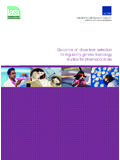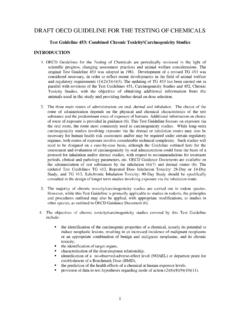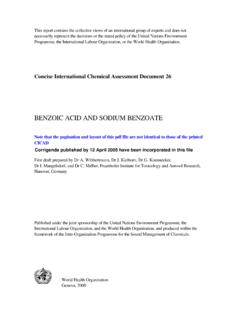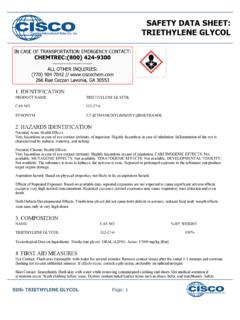Transcription of Demystifying FDA’s 505(b)(2) Drug Registration …
1 October 20091 Demystifying FDA s 505(b)(2) drug Registration ProcessBy Harriette L. Nadler, PhD and Damaris DeGraft-Johnson, RPh, MScRegulatory Focus2 The US Food and drug Administration s (FDA) legal/regulatory framework offers three path-ways to approval of New drug Applications (NDAs): 505(b)(1), 505(b)(2) and 505(j). This article provides an overview of the 505(b)(2) process in comparison to the other Registration processes. In 2008, more than half of the new drugs approved in the US utilized the 505(b)(2) Registration pathway. Of the 28 drug approvals in 2008 under this pathway, 50% were products with new formulations and the remainder were principally products with new molecular entities, changed active ingredients and new drug combi-nations.
2 This reflects an increase from 2006 and 2007, for which the percentages were 20% and 43%, 505(b)(2) application process shares some attributes with 505(b)(1) NDAs as well as (505(j) Abbreviated New drug Applications (ANDAs) for generic products (see Table 1).2 505(b)(2) and 505(j) applications share the requirement for conducting bioavailability/bioequivalence (BA/BE) studies of the proposed product with the FDA-approved Reference Listed drug (RLF). Both may rely on the agen-cy s previous finding of safety and efficacy for the RLD to support Sponsors may submit 505(j) ANDAs only when their new prod-uct and the RLD are bioequivalent4,5 and have identical characteristics ( , active ingredient, dosage form, strength, route of administration, uses, etc.))
3 The standard for approval (substantial evidence of safety and effectiveness) for 505(b)(2) drugs is the same as for 505(b)(1) ,7 However, 505(b)(2) applications may rely upon FDA s previous findings of safety and effective-ness as well as some changes, , of quality attributes, to the RLD. In addition, the sponsor must provide a demonstration of pharmacoki-netic (PK) BA/BE of the new product versus that of the certain instances, efficacy, safety and qual-ity attributes of the proposed or changed product need to be proven. A case study is provided to illustrate an instance when PK comparability or BA/BE studies had to be accompanied by new efficacy and safety studies. The 505(b)(2) drug application must meet the same requirements as a standalone NDA submitted under 505(b)(1), but not all of the information required for approval of 505(b)(2) drugs is necessarily derived from studies conducted by the sponsor.
4 And the Table 1. Similarities and Differences Between Registration RoutesRegulatory Process505(b)(1) 505(b)(2) 505(j)Agency MeetingsYesYesNoUser Fees YesYesNoReview Classification/Timeline9 + for approvalFull Reports of Efficacy/Safety StudiesYesMaybeNoPK/Bioavailability/Bioe quivalence Studies with RLDNAYesYesCMC Bridging Studies with RLDNAYesYesToxicology Bridging Studies with RLDNAM aybeNASupportive Publications on RLDNAM aybeNoFDA s Findings of Safety & Effectiveness for RLDNAYes2 Yes2 Extensive Stability DataYesMaybeLimitedExamples of Allowed Changes ( , from RLD)New Molecular (Chemical) EntityYesYes3 NoNew Active MoietyYesYes4 NoNew IndicationYesYesNoNew Route of Administration YesYes5No6 New Formulation YesYes5No6 New Ester, Salt or Other Non-covalent DerivativeYesYes5 NoNew Dosage Form or StrengthYesYes5No6 Combination ProductYesYesMaybe7Rx/OTC SwitchYesYesNoLabelingNAMaybeNoMarketing and Patent IssuesPatentedYesYesMaybeMarket ExclusivityYesYesNo81 FDA targets nine months for standard reviews, but a typical review is 10-12 months; may receive priority review and orphan drug designation which reduces target review time.
5 2 Reliance on summary information that is included in labeling. FDA does not permit citing innovator s specifics of individual stud-ies in FDA s Summary Basis of Approval for which a right of reference has not been obtained3 drug is not approved anywhere; drug is approved in non-US region; or is a product or active metabolite of approved drug . There also may be no therapeutic equivalent4 Molecule or ion, excluding the appended portions that cause the drug to be an ester, salt or other non-covalent derivative (complex, chelate, etc.), responsible for the physiological or pharmacological action of the drug substance5 Some changes may not be allowed; proposed changes need to be discussed with FDA as early as possible.
6 6 Citizen s suitability petition submitted to FDA for approval of a change in a listed drug7 Permitted when single active ingredient is substituted for one active ingredient of listed combination drug 8 Except against other generics approved after first application was approvedDemystifying FDA s 505(b)(2) drug Registration ProcessBy Harriette L. Nadler, PhD and Damaris DeGraft-Johnson, RPh, MScOctober 20093 Table 2: Case Study of a Neurologic Product Approved via the 505(b)(2) Registration RouteFDA review division Division of Neurology Products Allowed change from RLDA lternate route of administrationSponsor conduct of efficacy/safety studiesDouble-blind efficacy study in patients compared the proposed product (development formulation) to the RLD.
7 Primary efficacy endpoint showed a statistically significant difference in the changed product compared with the RLD. Superiority of the changed product versus the RLD could not be claimed in Section 14, Clinical Studies, of the product s labeling without conducting an additional study statistically powered to demonstrate superiority and also establishing concentrations of the drug necessary for the pharmacologic study of the final commercial product (FCP) in patients using the alternate route of administration was on literature search and agency findings of effectiveness and safetyLiterature summaries of each pertinent individual efficacy study were included in the NDA with details about general design, dose and duration, data were extracted and abstracts of studies were prepared and hyperlinked to original articles.
8 Bridging BA/BE studiesStepwise scenario was accepted by FDA for the PK comparability studies in which Product A was a development formulation and Product B (FCP) was the final commercial A = Product C (RLD) in PK study--Product A = Product B (FCP) in PK studyFDA s criteria for pharmacokinetic bioequivalence were met. 4 Sponsor demonstrated that rate and extent of absorption of the proposed product and the RLD were sufficiently similar so that abuse liability studies were not proportionality of low and high dosage forms of changed product in adults was similar to that of RLD as published in considered this demonstration adequate to support the use of the low-dosage form in geriatric or debilitated toxicological studiesSingle study was required in animals to demonstrate local safety/tolerability of alternate route of CMC studiesSome in vitro comparisons of the changed product to the RLD were required to address potential abuse of impurity profiles in accordance with relevant ICH guidelines was
9 Required, including evidence of no structural alerts for of appropriate quality control was required to demonstrate performance attributes. Deficiencies were not noted by FDA. Agency adviceOriginal NDA:Agency input regarding selection of the RLD was not sought prior to submission. Agency requested additional safety/tolerability data re: the alternate route of administration. Agency requested additional PK analyses to show that abuse liability was not a concern. Outcome: new NDA needed to address deficiencies. New NDA:A strategic pre-NDA meeting was conducted. The second filing addressed all agency concerns. Outcome: NDA approval. ComplianceGLP deficiencies: Reserve or retention drug samples to allow confirmation of identity of drugs assayed in PK BA/BE studies were not available at the clinical sites; however, other representative reserve samples were provided by the of assays conducted in two different bioanalytical labs was not done; however, other related verification data were estimates only from the high calibration curve were acceptable from a PK BA/BE bridging study.
10 Outcome: GLP compliance deficiencies were adequately addressed and considered in conjunction with clinical, PK and CMC findings of proposed product and extensive data publicly available for the deficiencies: Source documentation for a secondary endpoint was not sufficient. Outcome: deficiencies did not preclude of favorable PK or PD (pharmacodynamic or efficacy) differences between routes of administration was considered inadequate to warrant new efficacy studies were conducted with a development formulation, not the final commercial product; this observation did not preclude , aside from small changes in Sections 6 and 12 of the labeling, Adverse Events and Clinical Pharmacology, respectively, the approved labeling content was very close to that of the Focus4sponsor may not have obtained a right of refer-ence to the RLD, especially to the raw data ( , not in the public domain) used to summarize findings for Clinical Evidence of Safety and EffectivenessFor 505(b)(1) and 505(b)(2) drugs that warrant efficacy and safety studies, full safety, efficacy and selected clinical pharmacology reports (in instances agreed by FDA, , BA/BE bridge studies)





